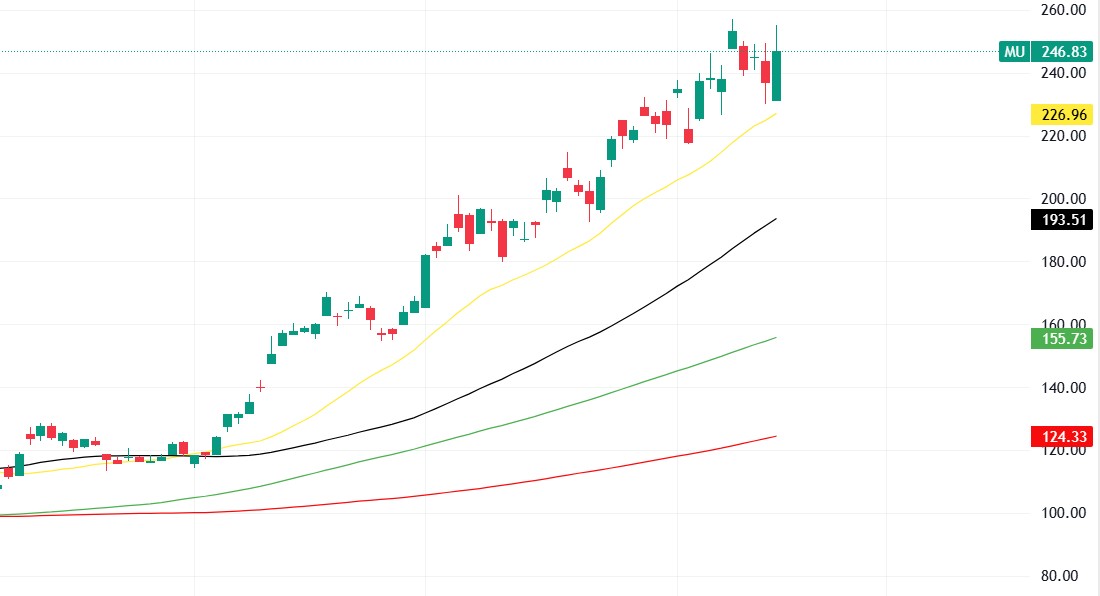Micron (MU) Memory Leader Riding the AI-Driven DRAM Supercycle
By Predictive Pick | November 17, 2025

Micron Technology, Inc. a longtime leader in memory and
storage — is once again gaining momentum. Over the past two months, the
stock has moved sharply higher, driven by tight memory supply and surging
demand from AI data centers. With its strong position in DRAM, NAND, and
high-bandwidth memory (HBM), Micron is poised to benefit significantly from the
ongoing memory upcycle.
What Micron Does
Micron is a key player in the semiconductor memory market.
Its product portfolio includes:
- DRAM
(Dynamic Random-Access Memory): Used in servers, PCs, and AI
workloads. Wikipedia+2babson.edu+2
- NAND
Flash: For SSDs, consumer devices, and data storage. Wikipedia+1
- High-Bandwidth
Memory (HBM): Critical for AI, high-performance computing, and
graphics. Micron Technology+1
In its fiscal Q2 2025 results, Micron reported $8.05
billion in revenue, with a strong increase in data-center DRAM sales. Micron Technology The company also crossed $1 billion in
HBM revenue in that quarter, highlighting the strength of its AI-focused
memory offerings. Micron Technology
Why MU Is Rallying Now
- Tight
Supply + Pricing Power
Micron recently announced price increases for 2025–2026, citing constrained supply and strong demand across DRAM, NAND, and HBM. TechPowerUp - AI-Driven
Demand Growth
According to Micron, DRAM bit demand is expected to grow in the high teens in 2025, fueled by AI data center builds. Nasdaq - Upbeat
Guidance
The company raised its Q4 fiscal 2025 guidance, citing improved DRAM pricing and better-than-expected demand. Investing.com India - Technological
Edge
Micron is pushing ahead with advanced memory nodes. Over 75% of its DRAM bits are on cutting-edge nodes, and it’s developing next-gen HBM (HBM4) with high bandwidth. Micron Technology+1 - Strong
Analyst Support
- Deutsche
Bank raised its target to $175, citing tight DRAM supply. Investing.com India
- UBS
also lifted its target, pointing to supply shortages and persistent
demand. Investing.com India
- Other
forecasts (e.g., from Capital.com) point to strong future growth. Capital
Key Risks to Consider
- Memory
Cyclicality: Memory markets historically go through boom-bust cycles.
If supply catches up or demand slows, prices could weaken.
- Capital
Intensity: Building and upgrading memory fabs is expensive; Micron’s
margins depend on high utilization.
- Geopolitical
Risk: Trade tensions, export restrictions, or regulations could impact
its global business.
- Competition:
Key rivals like Samsung and SK Hynix are advancing in HBM and DRAM.
Outlook & Potential Scenarios
- Base
Case (Medium-Term): Continued strength in AI data center demand drives
DRAM and HBM growth. Micron’s pricing remains firm, and its profitability
improves.
- Bull
Case: Strong HBM adoption (especially HBM4), tight supply conditions,
and long-term contracts lead to sustained pricing power and higher
margins.
- Bear
Case: Demand cools, or supply ramps faster than expected, putting
pressure on pricing and margins.
Conclusion
Micron (MU) is more than just a memory commodity play — it's
deeply positioned in the AI infrastructure boom. The recent price run reflects
real strength in demand and supply discipline. While the memory business is
cyclical, Micron’s technology leadership, pricing leverage, and AI exposure
make it one of the most compelling semis in this upcycle.
Disclaimer:
This article is for informational and educational purposes only. It is not
a recommendation to buy or sell MU shares. Investing in semiconductors and
memory stocks involves significant risk. Consult with a qualified financial
advisor before making any investment decisions.
Subscribe to our Blogs
Get the latest blog updates directly in your inbox.